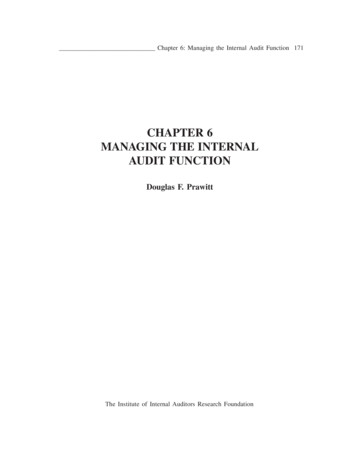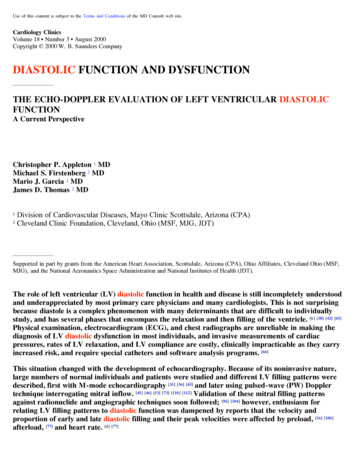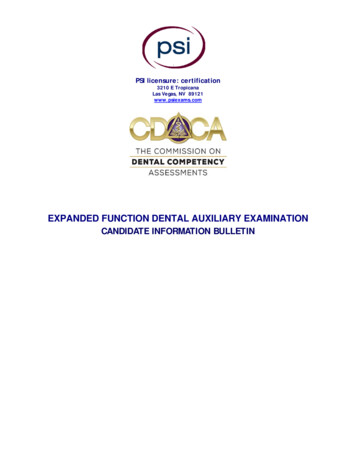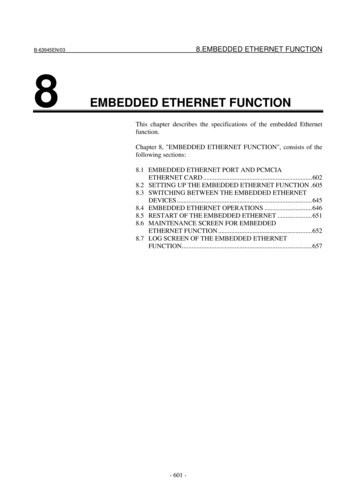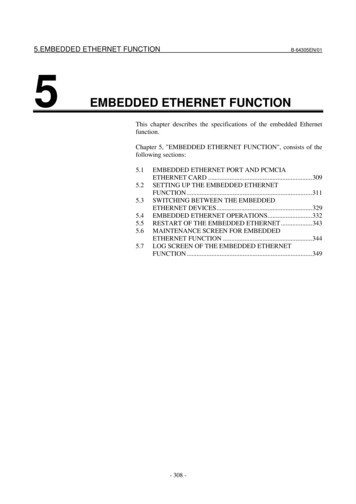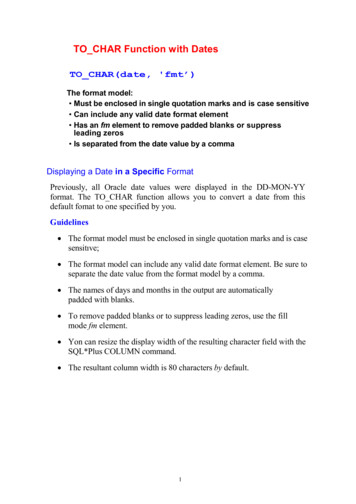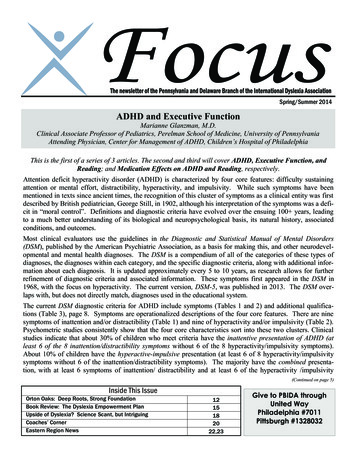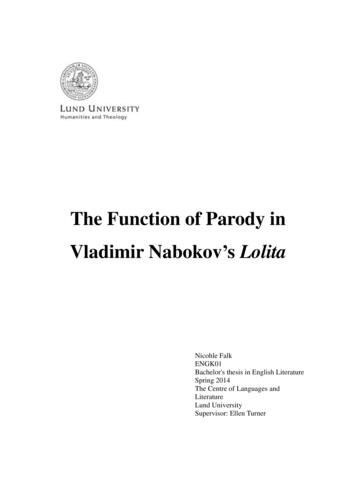
Transcription
The Function of Parody inVladimir Nabokov’s LolitaNicohle FalkENGK01Bachelor's thesis in English LiteratureSpring 2014The Centre of Languages andLiteratureLund UniversitySupervisor: Ellen Turner
Table of ContentsIntroduction.1What is Parody?.2Doppelgänger Parody.7Romance parody.14Parody of Psychoanalysis.18Conclusion.22Works Cited.24
IntroductionThe subject matter of Vladimir Nabokov's Lolita (1955) may at first glance seem rathersordid; a story about a middle-aged paedophile and his twelve-year-old stepdaughtereloping is certain to cause affront to many readers, unsurprisingly enough. Indeed,Nabokov had finished writing Lolita in 1953, but because of its controversial subject ittook two years and five rejections from American publishing houses before the bookwas accepted and published, and then only by Olympia Press in Paris, which,unbeknownst to Nabokov, was notorious for publishing cheap editions of pornographicbooks (Vickers 47). The book went largely unnoticed until it was praised by GrahamGreene in Sunday Times, and when Lolita was finally published in the U.S in 1958 itbecame an instant bestseller. It mainly received favourable reviews, although somereviewers accused it of being nothing more than highbrow pornography (Vickers 51).However, any reader picking up Lolita expecting cheap titillation would be deeplydisappointed.Lolita is a work which rewards closer examination. Nabokov himself stated thatthe book was about his love affair with the English language (Frosch 50), and Lolita isfilled with linguistic games, puns, literary allusions and coinages. Aside from theseword games, Lolita can also be interpreted as parodying a multitude of different genresand cultural practices. Most obviously, it is a parody of the Romantic Doppelgängergenre, with Clare Quilty cast as Humbert's evil double who stalks him throughout thenovel. Furthermore, Lolita can also be seen as a parody of literary styles such as thedetective story, the romance novel, the autobiography, and, importantly, as a parody ofpsychoanalysis. One can rightfully wonder what function and purpose all the parody,word games and literary allusions serve in the novel. Nabokov likened Lolita to a riddle,with an elegant solution, and warns his readers to expect “deceit bordering ondiabolism” (Ingham 27).To begin to find an answer to what the significance of parodying all of theseliterary forms is, it is important to first have a clear definition of what parody means.Traditionally, parody has been defined as an imitation of a literary work with the1
intention of mocking or ridiculing it. However, the way parody is used has changed overtime, and with the rise of post-modernism, new waysof parodying works haveemerged. According to Linda Hutcheon, parody does not necessarily need to be a wayof ridiculing earlier works, but rather that “parody is one of the major forms of modernself-reflexivity; it is a form of inter-art discourse” (2). Thus, parody is intimately linkedwith intertextuality. As parody is such a wide field within literature, there have been anumber of conflicting ways of defining exactly what it entails, which will be thoroughlydiscussed in the background section.The aim of this essay is to examine the function of parody in Lolita. In order todo this, I will start with a thorough discussion of the concept of parody within literature.This section will also bring up post-modernism, and some of its features, of whichparody is one. I will then examine how three different genres or cultural practices areparodied in Lolita, the Romantic Doppelgänger tale, the romance novel and, finally,psychoanalysis. Within these sections, literary convention and tradition will bediscussed, as well as an investigation of the intertextual links to the works which arebeing parodied. I will argue that parody is a form of prolepsis, a way for Nabokov tochallenge the pretensions of his readers, and to show that he can predict and pre-empttheir conclusions. Furthermore, I will illustrate how this is achieved by Nabokov'scareful placing of “traps” throughout the novel. It is all a part of Nabokov's “diabolical”game that he is playing with his readers. Moreover, I will also show how parody is away for Nabokov to escape the influence of his precursors; by parodyingpsychoanalysis and literary history he can claim originality in a world where everythinghas already been written or predicted by psychoanalysis.What is Parody?Parody as a literary genre is certainly not a recent invention. In fact, it is a term thatderives from Ancient Greek, with its earliest mention recorded in Aristotle's Poetics,where it is used in reference to Hegemon, an earlier writer (Dentith 10). Fred W.2
Householder defines the Ancient Greek parody as “a narrative poem of moderatelength, in epic meter, using epic vocabulary, and treating a light, satirical or mockheroic subject” (qtd in Rose 7). Of course, it is not surprising that a word, or term,which has been in continual use since Aristotle's time has been subject to a change inmeaning. Examining what different critics have said to be the definition of parody indifferent eras quickly makes it apparent that it does not have a fixed definition, butrather that the definition changes in accordance to the times and prevailing trends withinart and literature. Linda Hutcheon points to the fact that there are no trans-historicaldefinitions of parody (32), meaning that parody as a literary device has not been a staticconcept, but has altered depending on the time and place of use.With parody seemingly being such a fluid concept, it is a difficult task to settleon what definition to use. The Oxford English Dictionary defines parody as “[a] literarycomposition modelled on and imitating another work, especially a composition in whichthe characteristic style and themes of a particular author or genre are satirized by beingapplied to inappropriate or unlikely subjects, or are otherwise exaggerated for comiceffect.” Another slightly different definition is made by Simon Dentith, who argues that“[p]arody includes any cultural practice which provides a relatively polemical allusiveimitation of another cultural production or practice” (9). Thus, a parody does not have tobe based on a textual or literary source, but could be based on a variety of culturalpractices such as psychoanalysis, political ideologies and popular culture to name afew. However, Dentith also concedes that “because of the antiquity of the word parody because of the range of different practices to which it alludes, and because ofdiffering national usages, no classification can ever hope to be securely held in place”(6). This means that the many subjective interpretations of the term, its wide field ofusage, and simply its age make parody a very difficult concept to reach a conclusivedefinition of.Furthermore, Hutcheon contests the notion that parody has to include an elementof ridicule or mocking of the source text (6). Instead, her focus is on the inter-textualaspects of parody; she describes parody as “a formal or structural relation between twotexts” (22). However, not any two texts which relate to each other is parody, that wouldmerely be a case of inter-textuality. As Hutcheon remarks, in addition to the relation3
between the texts (or cultural practice and text), there also needs to be a clear intentionfrom the author of parodying the other work, and that the structure implies that theparody can be “decoded” by the reader (22-23). Inter-textuality is clearly central to thegenre of parody, although the source being parodied does not strictly need to be aliterary work, but can, to use Dentith's words, be any “cultural production or practice”(9). Neither does the parody necessarily have to criticise the text, genre or culturalproduction being parodied, but can be a way to “attack, satirise, or just playfully to referto elements of the contemporary world” by drawing on the “authority of precursortexts” (Dentith 9). In other words, parody can use the influence of its source to offer acomment on the surrounding world.All texts have to situate themselves in relation to the texts that have come beforethem, the “precursor” texts. Most writers strive for originality, but the weight of theprecursor texts can seem like a heavy yoke, impossible to escape. When everythingalready seems to have been written, originality can be difficult to claim. Additionally,there is also the problem of how parody can be original when it is an imitation ofsomething else. Hutcheon's answer to this is that writers use parody as a “mode ofemancipation” (35); it is a way for them to break free from tradition while at the sametime continuing to work within that tradition. Thus, parody is a way for writers todetach themselves from the influence of their precursors by imitating their work,“through ironic recoding or, ʻtrans-contextualizingʼ”, as Hutcheon puts it (101).What she means by this is that parody should stress the difference, or distance, from itssource rather than the similarities.The use of irony is central to the genre of parody. Irony is defined by Bran Nicolas “a non-literal usage of language, where what is said is contradicted by what is meant(either deliberately or unwittingly) or what is said is subverted by the particular contextin which it is said” (13). This places certain demands on the reader; to understand whatthe text is really saying, one cannot take it at face value but is forced to decode thelayers of meaning. Hutcheon argues that the “implied distance” between the parody andthe source text is usually signalled by irony, but that irony is not necessarily used in anegative way. According to Hutcheon, “irony can be playful as well as belittling; it canbe critically constructive as well as destructive. The pleasure of parody's irony comes4
not from humor in particular but from the degree of engagement of the reader in theintertextual ʻbouncingʼ . between complicity and distance” (32). Irony, then, is aversatile device which allows writers to link their work to earlier ones whilemaintaining a distance. This ironic distance is the difference which makes parody notjust an imitation of the source, but sets it apart and offers a comment. Nicol states that“[i]rony enables writers to continue working within particular discourses whilesimultaneously managing to contest them” (32), which strengthens the argument thatparody is a way for writers to break with the past, even though it is done by imitatingearlier works or genres.Irony and parody are also important features of post-modernism, a movementwhich, just like parody, resists a fixed definition. Some of the main features of postmodern literature are self-reflexivity, meta-fiction, and the idea that the world can onlybe understood through language. Meta-fiction can be described as fiction which is selfconscious, “[drawing] attention to its own status as writing” (Peck and Coyle 137).Other important characteristics of post-modernist fiction include mixing differentgenres, and jumbling high and low culture (137). It also represents a step away fromrealism and the notion that reality can, and should, be accurately reproduced in art andliterature (Nicol 18). Instead, post-modernism stresses the notion that fiction is aʻconstructionʼ, not a ʻtranscriptionʼ (Nicol 23), often using unreliable narrators. Itimplies that images and reality are one and the same. Charles Jencks states that toqualify as post-modernist, a work should be what he calls ʻdouble-codedʼ (qtd in Nicol15). Originally used in the context of architecture, double-coding means the bringingtogether of two spheres, old and new, and it is this mode of “doing two things at thesame time” which makes it “an ironic technique” (Nicol 15). This also links in neatlywith theories on parody and intertextuality, as they do exactly this, merge new and oldand bring together different spheres. According to Umberto Eco, post-modernismemerges when writers recognise this:[They] cannot go any further without lapsing into silence. They reach this point because in thepursuit of the new they have to “destroy” the past. However, art must continue, and so the onlysolution for those who come after the modernists is to engage with the past once again. Therenewed engagement with the past is made possible through the use of irony, paradoxically5
saying something new, but only by acknowledging that it has already been said. (qtd in Nicol 14)This idea that the only way to move forward is to re-engage with the past through ironyfurther indicates that parody is a vital part of post-modern fiction. Nabokov did notconsider himself a post-modernist writer, largely because he was not aware of themovement after having left the United States in the early sixties (Couturier 248).However, many of his works, and particularly Lolita, display several post-modernistfeatures earlier mentioned, such as unreliable narration, mixing high and low culture,double-coding, self-reflexivity and, above all, parody. The idea that Nabokov's workshould be situated within post-modernist fiction is corroborated by Richard Poirier in anessay called “The Politics of Self-Parody”, published
The subject matter of Vladimir Nabokov's Lolita (1955) may at first glance seem rather sordid; a story about a middle-aged paedophile and his twelve-year-old stepdaughter eloping is certain to cause affront to many readers, unsurprisingly enough. Indeed, Nabokov had finished writing Lolita in 1953, but because of its controversial subject it took two years and five rejections from American .

